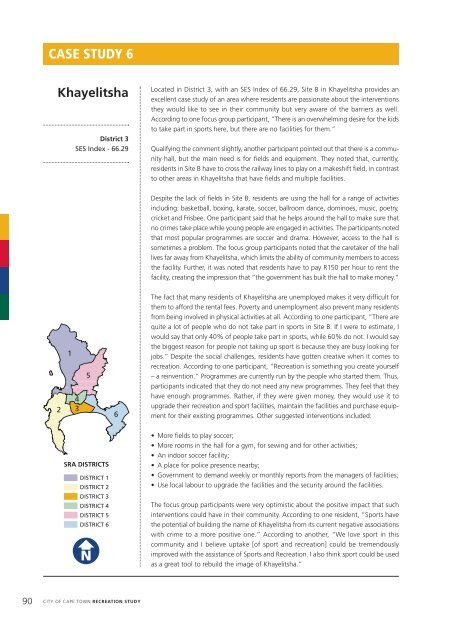Recreation Study
Recreation Study
Recreation Study
- No tags were found...
You also want an ePaper? Increase the reach of your titles
YUMPU automatically turns print PDFs into web optimized ePapers that Google loves.
CASE STUDY 6KhayelitshaDistrict 3SES Index - 66.29Located in District 3, with an SES Index of 66.29, Site B in Khayelitsha provides anexcellent case study of an area where residents are passionate about the interventionsthey would like to see in their community but very aware of the barriers as well.According to one focus group participant, “There is an overwhelming desire for the kidsto take part in sports here, but there are no facilities for them.”Qualifying the comment slightly, another participant pointed out that there is a communityhall, but the main need is for fields and equipment. They noted that, currently,residents in Site B have to cross the railway lines to play on a makeshift field, in contrastto other areas in Khayelitsha that have fields and multiple facilities.Despite the lack of fields in Site B, residents are using the hall for a range of activitiesincluding: basketball, boxing, karate, soccer, ballroom dance, dominoes, music, poetry,cricket and Frisbee. One participant said that he helps around the hall to make sure thatno crimes take place while young people are engaged in activities. The participants notedthat most popular programmes are soccer and drama. However, access to the hall issometimes a problem. The focus group participants noted that the caretaker of the halllives far away from Khayelitsha, which limits the ability of community members to accessthe facility. Further, it was noted that residents have to pay R150 per hour to rent thefacility, creating the impression that “the government has built the hall to make money.”142 356The fact that many residents of Khayelitsha are unemployed makes it very difficult forthem to afford the rental fees. Poverty and unemployment also prevent many residentsfrom being involved in physical activities at all. According to one participant, “There arequite a lot of people who do not take part in sports in Site B. If I were to estimate, Iwould say that only 40% of people take part in sports, while 60% do not. I would saythe biggest reason for people not taking up sport is because they are busy looking forjobs.” Despite the social challenges, residents have gotten creative when it comes torecreation. According to one participant, “<strong>Recreation</strong> is something you create yourself– a reinvention.” Programmes are currently run by the people who started them. Thus,participants indicated that they do not need any new programmes. They feel that theyhave enough programmes. Rather, if they were given money, they would use it toupgrade their recreation and sport facilities, maintain the facilities and purchase equipmentfor their existing programmes. Other suggested interventions included:SRA DISTRICTSDISTRICT 1DISTRICT 2DISTRICT 3DISTRICT 4DISTRICT 5DISTRICT 6• More fields to play soccer;• More rooms in the hall for a gym, for sewing and for other activities;• An indoor soccer facility;• A place for police presence nearby;• Government to demand weekly or monthly reports from the managers of facilities;• Use local labour to upgrade the facilities and the security around the facilities.The focus group participants were very optimistic about the positive impact that suchinterventions could have in their community. According to one resident, “Sports havethe potential of building the name of Khayelitsha from its current negative associationswith crime to a more positive one.” According to another, “We love sport in thiscommunity and I believe uptake [of sport and recreation] could be tremendouslyimproved with the assistance of Sports and <strong>Recreation</strong>. I also think sport could be usedas a great tool to rebuild the image of Khayelitsha.”90 CITY OF CAPE TOWN RECREATION STUDY


